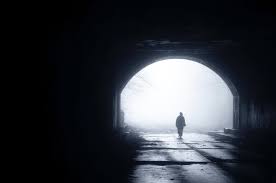Introduction to Shema and its Berachot (2) – Foundational Texts (2) – Bavli 11a
 Last time we explored the Yerushalmi’s brief commentary on the Mishna, which offered two sources for the idea of berachot recited before and after the Shema. Let us now turn to the Bavli to see what its rabbis are thinking about in this regard.
Last time we explored the Yerushalmi’s brief commentary on the Mishna, which offered two sources for the idea of berachot recited before and after the Shema. Let us now turn to the Bavli to see what its rabbis are thinking about in this regard.
בבלי ברכות י”א.
מַאי מְבָרֵךְ?
אָמַר רַבִּי יַעֲקֹב אָמַר רַבִּי אוֹשַׁעְיָא יוֹצֵר אוֹר וּבוֹרֵא חֹשֶׁךְ.
Bavli, Berachot 11a
What is the beracha? R. Yaakov said in the name of R. Yoshia, “Yotzer or u’vorei choshech – God creates light and fashioned darkness.”
The language of this beracha draws on a verse from the 45th chapter of Isaiah. Here is the opening of the chapter and the context of the verse:
ישעיהו מ”ה:א, ד-ז
(א) כֹּה אָמַר יְקֹוָק לִמְשִׁיחוֹ לְכוֹרֶשׁ אֲשֶׁר הֶחֱזַקְתִּי בִימִינוֹ לְרַד לְפָנָיו גּוֹיִם וּמָתְנֵי מְלָכִים אֲפַתֵּחַ לִפְתֹּחַ לְפָנָיו דְּלָתַיִם וּשְׁעָרִים לֹא יִסָּגֵרוּ: (ב) אֲנִי לְפָנֶיךָ אֵלֵךְ וַהֲדוּרִים אושר אֲיַשֵּׁר דַּלְתוֹת נְחוּשָׁה אֲשַׁבֵּר וּבְרִיחֵי בַרְזֶל אֲגַדֵּעַ: (ג) וְנָתַתִּי לְךָ אוֹצְרוֹת חֹשֶׁךְ וּמַטְמֻנֵי מִסְתָּרִים לְמַעַן תֵּדַע כִּי אֲנִי יְקֹוָק הַקּוֹרֵא בְשִׁמְךָ אֱלֹהֵי יִשְׂרָאֵל: (ד) לְמַעַן עַבְדִּי יַעֲקֹב וְיִשְׂרָאֵל בְּחִירִי וָאֶקְרָא לְךָ בִּשְׁמֶךָ אֲכַנְּךָ וְלֹא יְדַעְתָּנִי: (ה) אֲנִי יְקֹוָק וְאֵין עוֹד זוּלָתִי אֵין אֱלֹהִים אֲאַזֶּרְךָ וְלֹא יְדַעְתָּנִי: (ו) לְמַעַן יֵדְעוּ מִמִּזְרַח שֶׁמֶשׁ וּמִמַּעֲרָבָה כִּי אֶפֶס בִּלְעָדָי אֲנִי יְקֹוָק וְאֵין עוֹד: (ז) יוֹצֵר אוֹר וּבוֹרֵא חֹשֶׁךְ עֹשֶׂה שָׁלוֹם וּבוֹרֵא רָע אֲנִי יְקֹוָק עֹשֶׂה כָל אֵלֶּה:
Isaiah 45:1, 4-7
(1) Thus said the Lord to Cyrus, His anointed one…(4) For the sake of My servant Jacob, Israel My chosen one, I call you by name, I hail you by title, though you have not known Me. (5) I am the Lord and there is none else; beside Me, there is no god. I engird you, though you have not known Me, (6) So that they may know, from east to west, that there is none but Me. I am the Lord and there is none else, (7) I create light and fashion darkness, I make peace and fashion evil — I the Lord do all these things.
The gemara now notes that the beracha as it appears in the siddur is different from the language of the prophet. Here is the text as we have it as part of the liturgy:
יוֹצֵר אוֹר וּבוֹרֵא חֹשֶׁךְ עֹשֶׂה שָׁלוֹם וּבוֹרֵא אֶת הַכֹּל
I create light and fashion darkness, I make peace and fashion everything
This change is not insignificant, let’s see how the gemara addresses it (Berachot 12b):
לֵימָא יוֹצֵר אוֹר וּבוֹרֵא נוֹגַהּ [כינוי ללילה ע”פ פסחים ג.]? כְּדִכְתִיב קָאָמְרִינַן.
אֶלָּא מֵעַתָּה עֹשֶׂה שָׁלוֹם וּבוֹרֵא רָע מִי קָא אָמְרִינַן כְּדִכְתִיב אֶלָּא כְּתִיב רַע וְקָרֵינַן הַכֹּל לִישָּׁנָא מְעַלְּיָא, הָכָא נָמֵי לֵימָא נוֹגַהּ לִישָּׁנָא מְעַלְּיָא?
Let him say, “[God] Who creates light and fashions brightness (noga1)”? We say the blessing as the verse is written in the Bible. But if so, do we say, “I make peace and fashion evil” as it is written [in the Navi]? Rather, it is written “[creator of] evil” and we euphemistically say “[creator of] everything?” Here, too, let us euphemistically say brightness (noga) instead of darkness.
The gemara seems to entertain and then reject the possibility that the siddur chose the language of the beracha in order to speak euphemistically about evil or night. In the end, the sugya rejects that idea and offers a different explanation for the change in language from the verse:
אֶלָּא אָמַר רָבָא כְּדַי לְהַזְכִּיר מִדַּת יוֹם בַּלַּיְלָה וּמִדַּת לַיְלָה בַּיּוֹם.
Rather, Rava said: (The reason we recite: “Who creates darkness”) is in order to mention the attribute of day at night and the attribute of night during the day.
This idea – the obligation to make the day and the night be the same – is a key theme of this section. We saw that the commentaries on the Yerushalmi said something similar about both verses that they quoted as the source for the idea of the berachot themselves. Built into the structure of these blessings is a religious desire to show that God can be found both in the day and the night. God is present both in our moments of great joy as well as deep sorrow.
In the current pandemic environment, this is a painful concept. The rabbis understand the strong human impulse to disassociate the suffering of the world from God. Indeed, all of us want to find a “natural” explanation for pain that does not implicate Hashem. The problem of theodicy is as old as humanity, and I would not be so arrogant as to think that I could offer a sufficient response to those questions.
However, I believe that the rabbis are trying to help us to see the world in a different way. They want us to understand that, in fact, everything is from God. Just as we might recite a beracha over Hallel on Yom ha-Atzmaut, we also cry through Yom ha-Shoah with a keen awareness of divine absence.
A central message of prayer in general, and this section in particular, is to learn to see the light in the darkness and to always be aware of the darkness in the light, which enables us to resist the dualist or Deist notion that God is only available to us in one state or the other. I pray that we only need to celebrate smachot, but I am keenly aware that the reality of life is complex and messy.
 The next section of the
The next section of the